Analyzing Innovation at General Motors: A Business Report
VerifiedAdded on 2020/11/12
|11
|3219
|171
Report
AI Summary
This report examines the innovative practices of General Motors (GM), an American multinational automotive manufacturer. It analyzes GM's innovation history, focusing on key technological advancements such as the electric starter, automatic transmission, and OnStar system. The report employs PESTLE analysis to identify drivers of innovation, including political, economic, social, technological, legal, and environmental factors. It also assesses GM's existing innovation performance, highlighting investments in R&D and new technologies like zero-emission vehicles and eco-friendly propulsion systems. A SWOT analysis evaluates GM's strengths (e.g., joint ventures in China, satellite technology) and weaknesses (e.g., brand recognition, lack of substitute energy vehicles), as well as opportunities (e.g., increasing demand for SUVs, rising consumer expectations) and threats (e.g., financial crises, fuel prices). The report concludes with an overview of the automobile industry, emphasizing the importance of innovation in areas like driverless cars and advanced driver-assistance systems, and recommends that GM invest in hybrid technologies to meet current customer preferences.
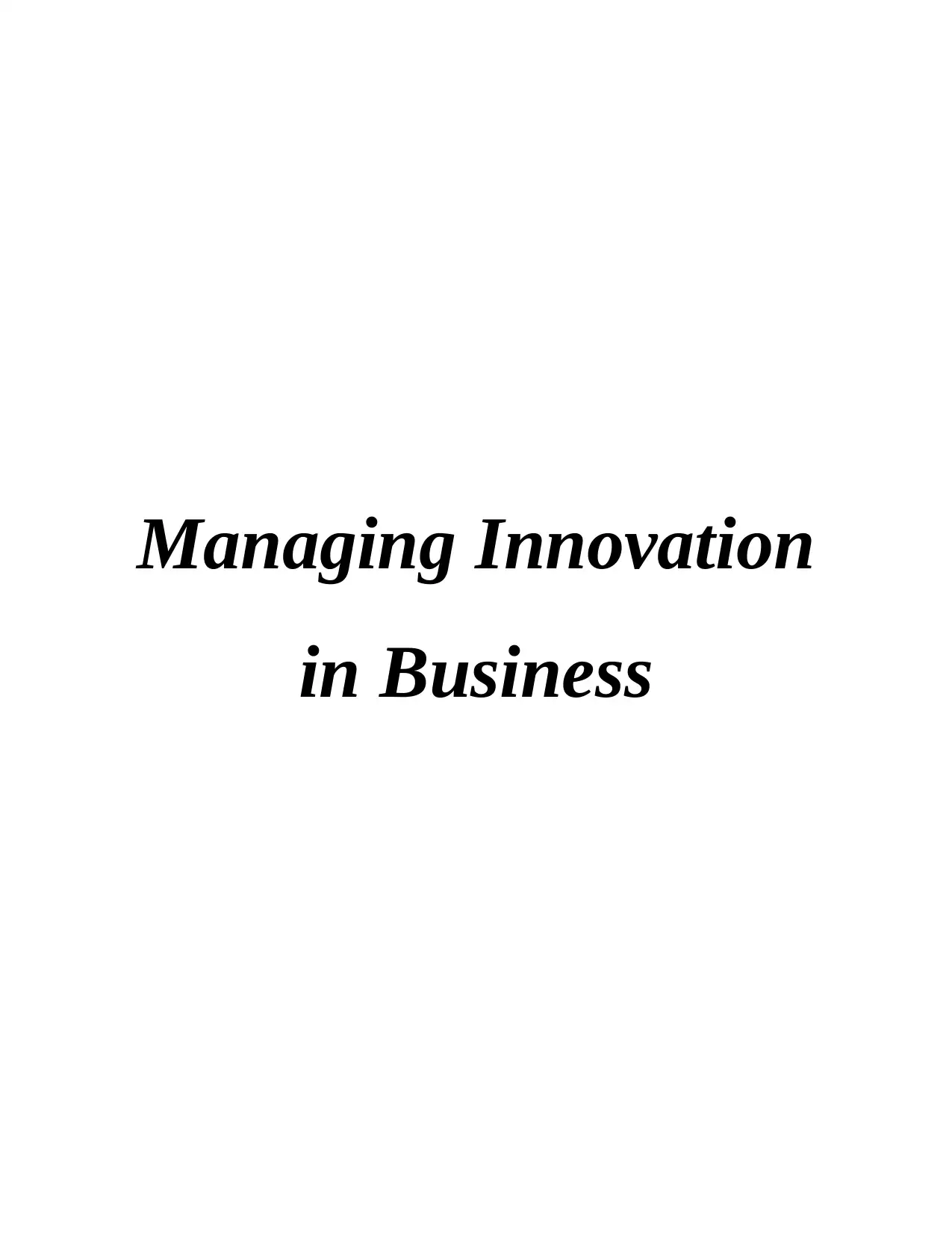
Managing Innovation
in Business
in Business
Paraphrase This Document
Need a fresh take? Get an instant paraphrase of this document with our AI Paraphraser
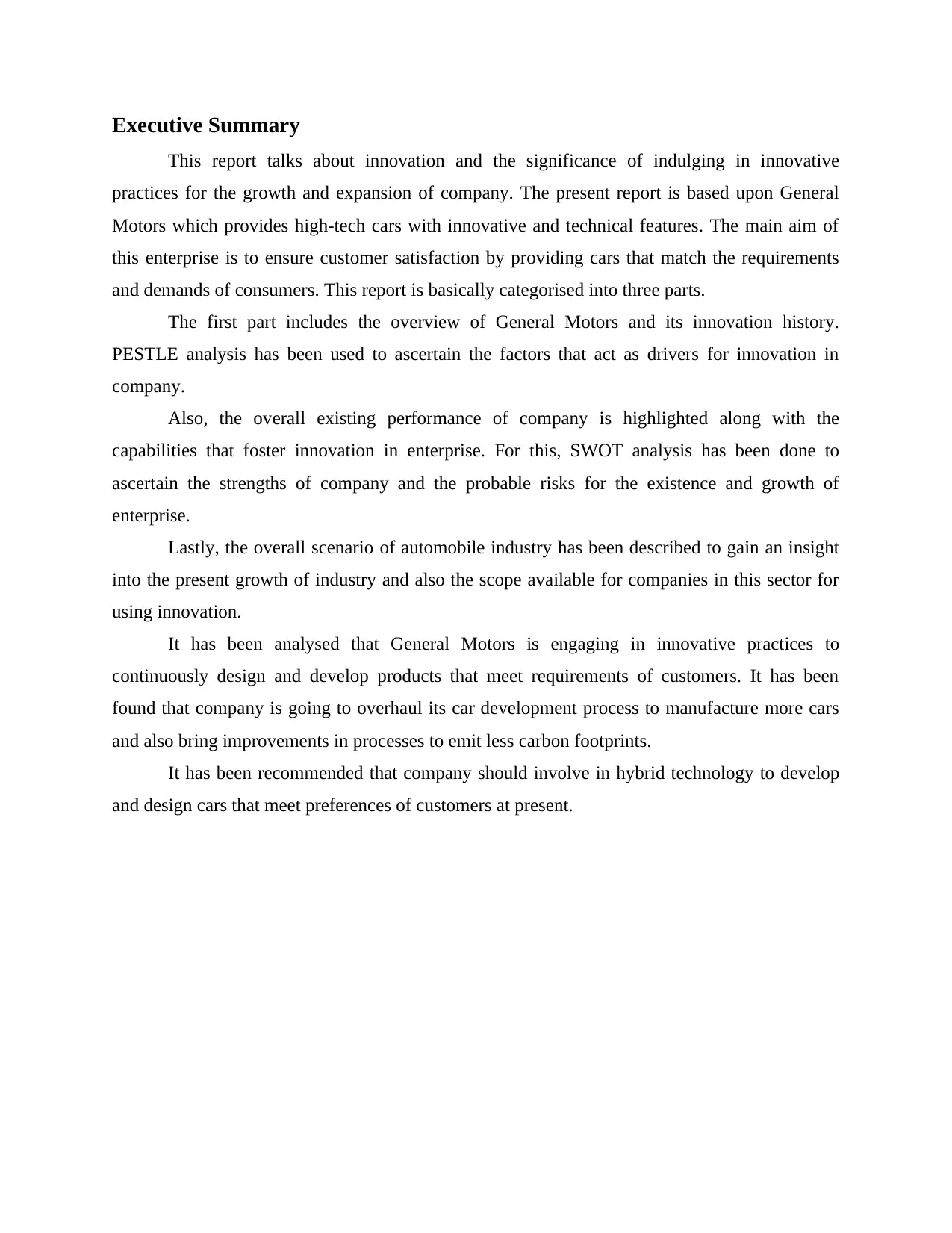
Executive Summary
This report talks about innovation and the significance of indulging in innovative
practices for the growth and expansion of company. The present report is based upon General
Motors which provides high-tech cars with innovative and technical features. The main aim of
this enterprise is to ensure customer satisfaction by providing cars that match the requirements
and demands of consumers. This report is basically categorised into three parts.
The first part includes the overview of General Motors and its innovation history.
PESTLE analysis has been used to ascertain the factors that act as drivers for innovation in
company.
Also, the overall existing performance of company is highlighted along with the
capabilities that foster innovation in enterprise. For this, SWOT analysis has been done to
ascertain the strengths of company and the probable risks for the existence and growth of
enterprise.
Lastly, the overall scenario of automobile industry has been described to gain an insight
into the present growth of industry and also the scope available for companies in this sector for
using innovation.
It has been analysed that General Motors is engaging in innovative practices to
continuously design and develop products that meet requirements of customers. It has been
found that company is going to overhaul its car development process to manufacture more cars
and also bring improvements in processes to emit less carbon footprints.
It has been recommended that company should involve in hybrid technology to develop
and design cars that meet preferences of customers at present.
This report talks about innovation and the significance of indulging in innovative
practices for the growth and expansion of company. The present report is based upon General
Motors which provides high-tech cars with innovative and technical features. The main aim of
this enterprise is to ensure customer satisfaction by providing cars that match the requirements
and demands of consumers. This report is basically categorised into three parts.
The first part includes the overview of General Motors and its innovation history.
PESTLE analysis has been used to ascertain the factors that act as drivers for innovation in
company.
Also, the overall existing performance of company is highlighted along with the
capabilities that foster innovation in enterprise. For this, SWOT analysis has been done to
ascertain the strengths of company and the probable risks for the existence and growth of
enterprise.
Lastly, the overall scenario of automobile industry has been described to gain an insight
into the present growth of industry and also the scope available for companies in this sector for
using innovation.
It has been analysed that General Motors is engaging in innovative practices to
continuously design and develop products that meet requirements of customers. It has been
found that company is going to overhaul its car development process to manufacture more cars
and also bring improvements in processes to emit less carbon footprints.
It has been recommended that company should involve in hybrid technology to develop
and design cars that meet preferences of customers at present.
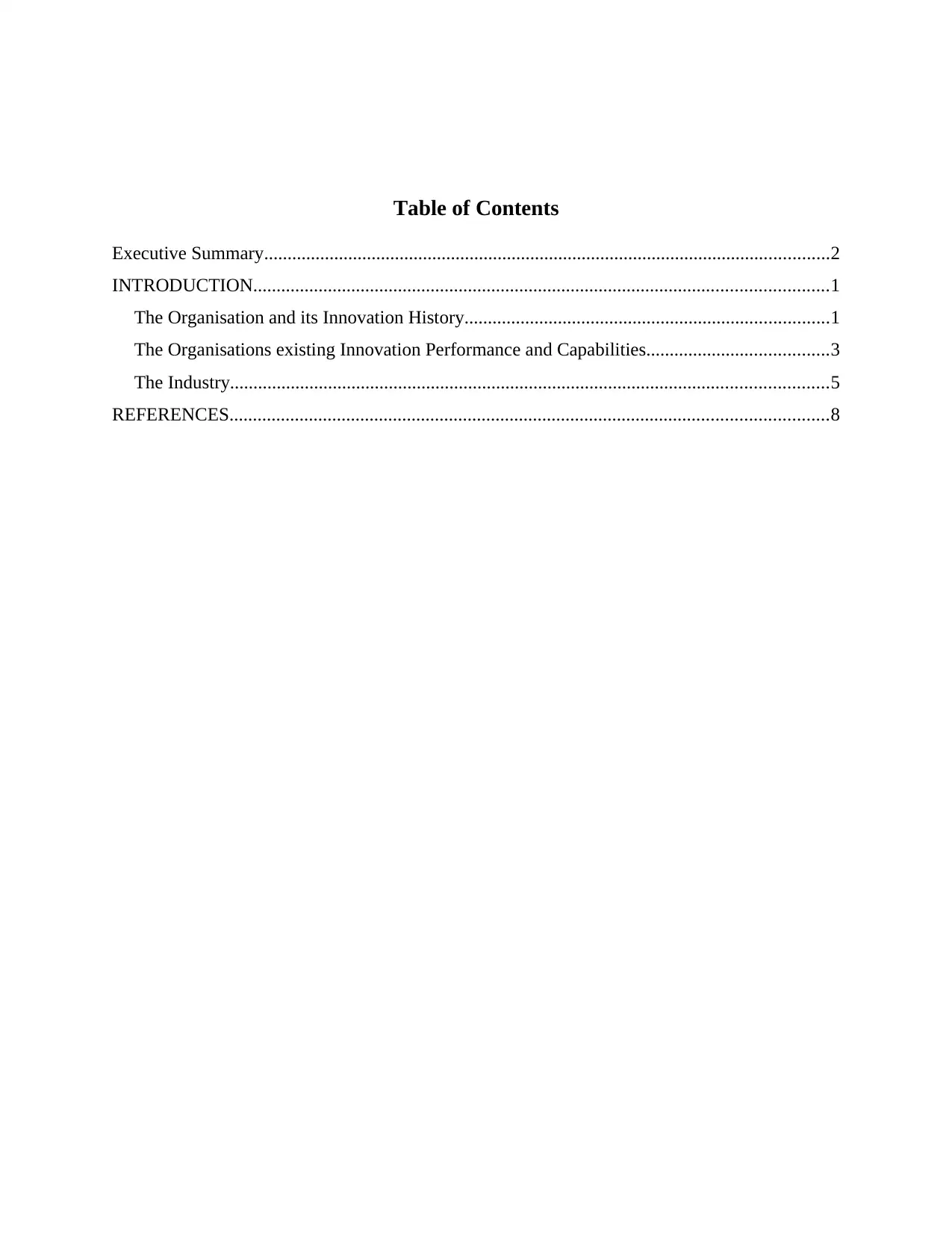
Table of Contents
Executive Summary.........................................................................................................................2
INTRODUCTION...........................................................................................................................1
The Organisation and its Innovation History..............................................................................1
The Organisations existing Innovation Performance and Capabilities.......................................3
The Industry................................................................................................................................5
REFERENCES................................................................................................................................8
Executive Summary.........................................................................................................................2
INTRODUCTION...........................................................................................................................1
The Organisation and its Innovation History..............................................................................1
The Organisations existing Innovation Performance and Capabilities.......................................3
The Industry................................................................................................................................5
REFERENCES................................................................................................................................8
⊘ This is a preview!⊘
Do you want full access?
Subscribe today to unlock all pages.

Trusted by 1+ million students worldwide
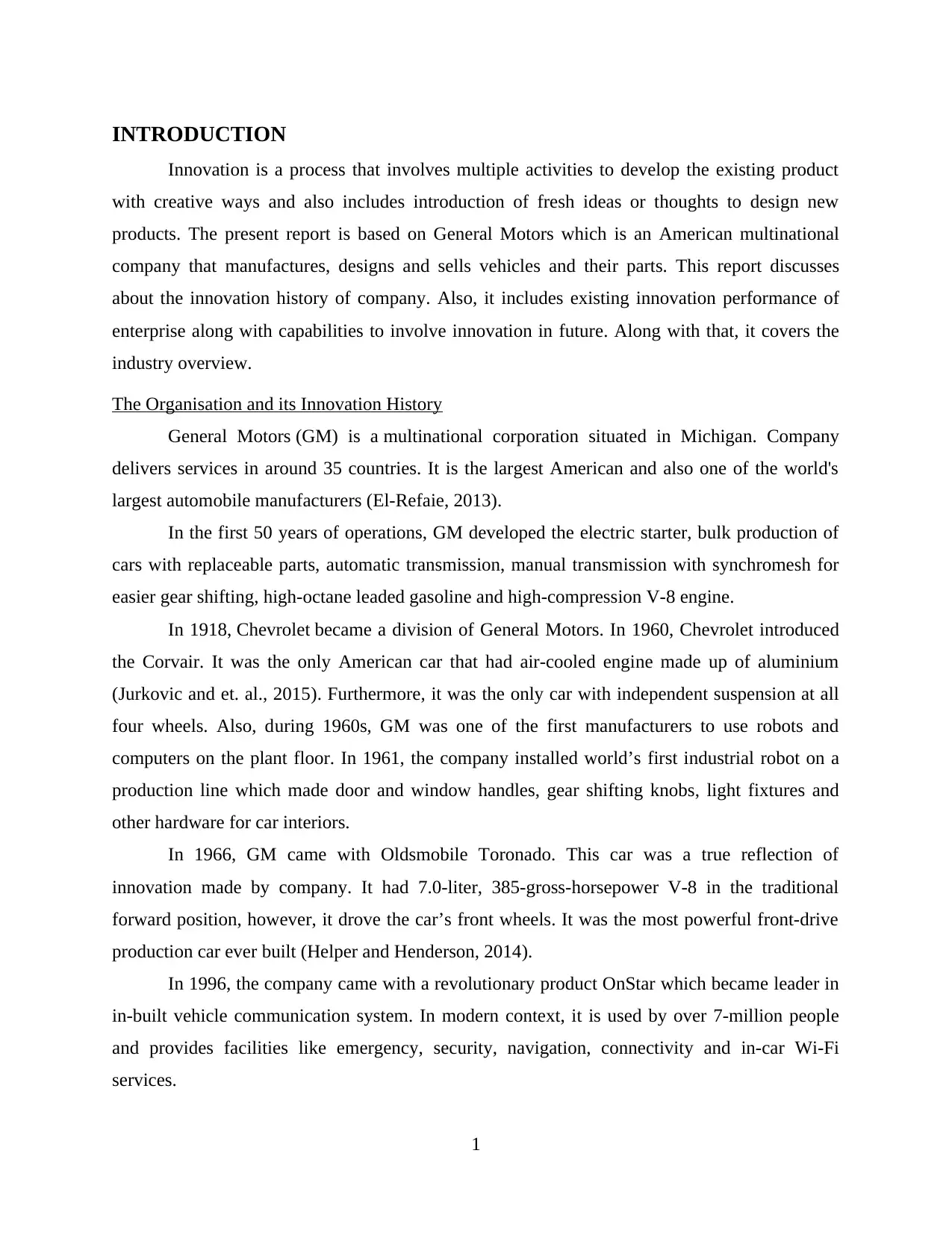
INTRODUCTION
Innovation is a process that involves multiple activities to develop the existing product
with creative ways and also includes introduction of fresh ideas or thoughts to design new
products. The present report is based on General Motors which is an American multinational
company that manufactures, designs and sells vehicles and their parts. This report discusses
about the innovation history of company. Also, it includes existing innovation performance of
enterprise along with capabilities to involve innovation in future. Along with that, it covers the
industry overview.
The Organisation and its Innovation History
General Motors (GM) is a multinational corporation situated in Michigan. Company
delivers services in around 35 countries. It is the largest American and also one of the world's
largest automobile manufacturers (El-Refaie, 2013).
In the first 50 years of operations, GM developed the electric starter, bulk production of
cars with replaceable parts, automatic transmission, manual transmission with synchromesh for
easier gear shifting, high-octane leaded gasoline and high-compression V-8 engine.
In 1918, Chevrolet became a division of General Motors. In 1960, Chevrolet introduced
the Corvair. It was the only American car that had air-cooled engine made up of aluminium
(Jurkovic and et. al., 2015). Furthermore, it was the only car with independent suspension at all
four wheels. Also, during 1960s, GM was one of the first manufacturers to use robots and
computers on the plant floor. In 1961, the company installed world’s first industrial robot on a
production line which made door and window handles, gear shifting knobs, light fixtures and
other hardware for car interiors.
In 1966, GM came with Oldsmobile Toronado. This car was a true reflection of
innovation made by company. It had 7.0-liter, 385-gross-horsepower V-8 in the traditional
forward position, however, it drove the car’s front wheels. It was the most powerful front-drive
production car ever built (Helper and Henderson, 2014).
In 1996, the company came with a revolutionary product OnStar which became leader in
in-built vehicle communication system. In modern context, it is used by over 7-million people
and provides facilities like emergency, security, navigation, connectivity and in-car Wi-Fi
services.
1
Innovation is a process that involves multiple activities to develop the existing product
with creative ways and also includes introduction of fresh ideas or thoughts to design new
products. The present report is based on General Motors which is an American multinational
company that manufactures, designs and sells vehicles and their parts. This report discusses
about the innovation history of company. Also, it includes existing innovation performance of
enterprise along with capabilities to involve innovation in future. Along with that, it covers the
industry overview.
The Organisation and its Innovation History
General Motors (GM) is a multinational corporation situated in Michigan. Company
delivers services in around 35 countries. It is the largest American and also one of the world's
largest automobile manufacturers (El-Refaie, 2013).
In the first 50 years of operations, GM developed the electric starter, bulk production of
cars with replaceable parts, automatic transmission, manual transmission with synchromesh for
easier gear shifting, high-octane leaded gasoline and high-compression V-8 engine.
In 1918, Chevrolet became a division of General Motors. In 1960, Chevrolet introduced
the Corvair. It was the only American car that had air-cooled engine made up of aluminium
(Jurkovic and et. al., 2015). Furthermore, it was the only car with independent suspension at all
four wheels. Also, during 1960s, GM was one of the first manufacturers to use robots and
computers on the plant floor. In 1961, the company installed world’s first industrial robot on a
production line which made door and window handles, gear shifting knobs, light fixtures and
other hardware for car interiors.
In 1966, GM came with Oldsmobile Toronado. This car was a true reflection of
innovation made by company. It had 7.0-liter, 385-gross-horsepower V-8 in the traditional
forward position, however, it drove the car’s front wheels. It was the most powerful front-drive
production car ever built (Helper and Henderson, 2014).
In 1996, the company came with a revolutionary product OnStar which became leader in
in-built vehicle communication system. In modern context, it is used by over 7-million people
and provides facilities like emergency, security, navigation, connectivity and in-car Wi-Fi
services.
1
Paraphrase This Document
Need a fresh take? Get an instant paraphrase of this document with our AI Paraphraser
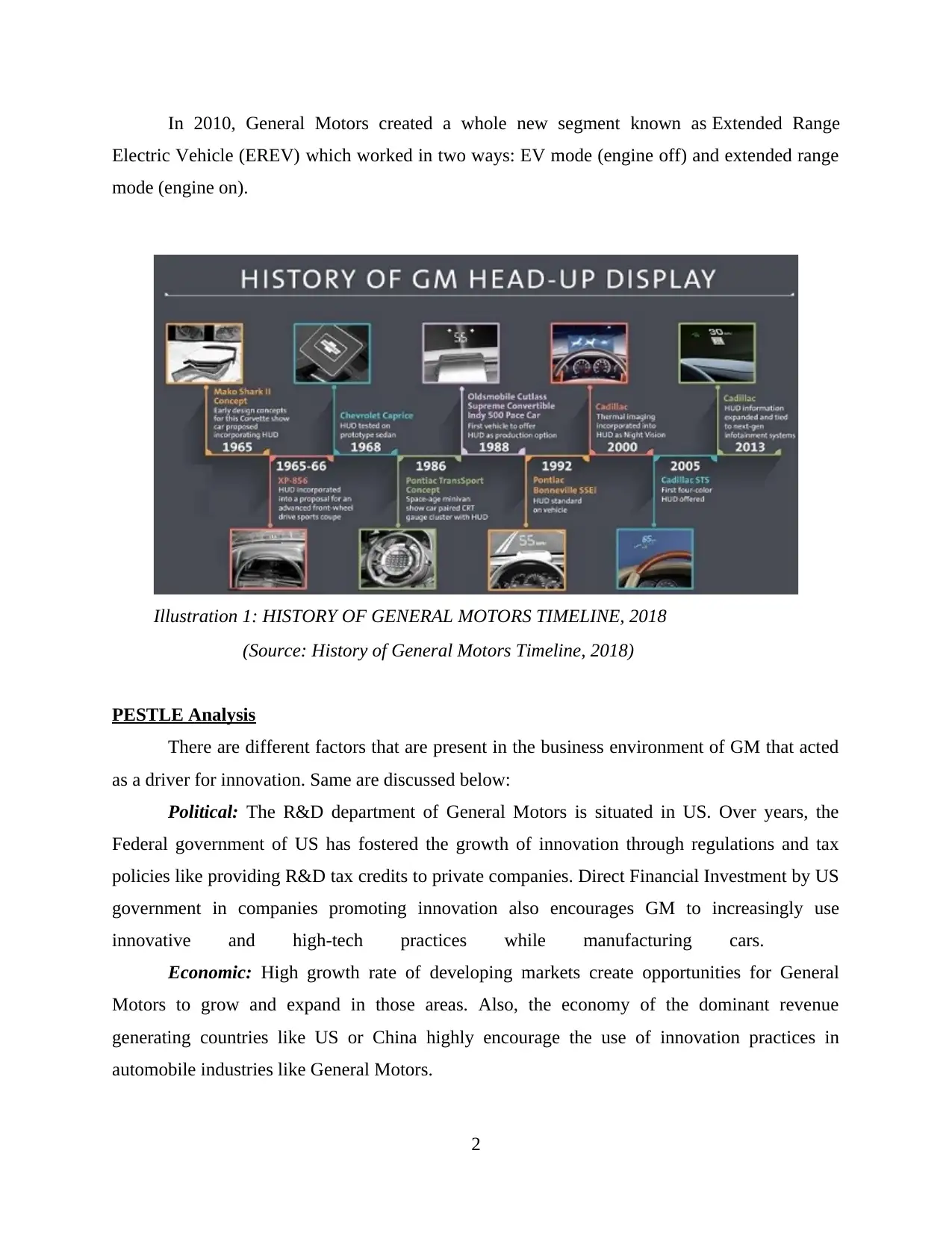
In 2010, General Motors created a whole new segment known as Extended Range
Electric Vehicle (EREV) which worked in two ways: EV mode (engine off) and extended range
mode (engine on).
(Source: History of General Motors Timeline, 2018)
PESTLE Analysis
There are different factors that are present in the business environment of GM that acted
as a driver for innovation. Same are discussed below:
Political: The R&D department of General Motors is situated in US. Over years, the
Federal government of US has fostered the growth of innovation through regulations and tax
policies like providing R&D tax credits to private companies. Direct Financial Investment by US
government in companies promoting innovation also encourages GM to increasingly use
innovative and high-tech practices while manufacturing cars.
Economic: High growth rate of developing markets create opportunities for General
Motors to grow and expand in those areas. Also, the economy of the dominant revenue
generating countries like US or China highly encourage the use of innovation practices in
automobile industries like General Motors.
2
Illustration 1: HISTORY OF GENERAL MOTORS TIMELINE, 2018
Electric Vehicle (EREV) which worked in two ways: EV mode (engine off) and extended range
mode (engine on).
(Source: History of General Motors Timeline, 2018)
PESTLE Analysis
There are different factors that are present in the business environment of GM that acted
as a driver for innovation. Same are discussed below:
Political: The R&D department of General Motors is situated in US. Over years, the
Federal government of US has fostered the growth of innovation through regulations and tax
policies like providing R&D tax credits to private companies. Direct Financial Investment by US
government in companies promoting innovation also encourages GM to increasingly use
innovative and high-tech practices while manufacturing cars.
Economic: High growth rate of developing markets create opportunities for General
Motors to grow and expand in those areas. Also, the economy of the dominant revenue
generating countries like US or China highly encourage the use of innovation practices in
automobile industries like General Motors.
2
Illustration 1: HISTORY OF GENERAL MOTORS TIMELINE, 2018
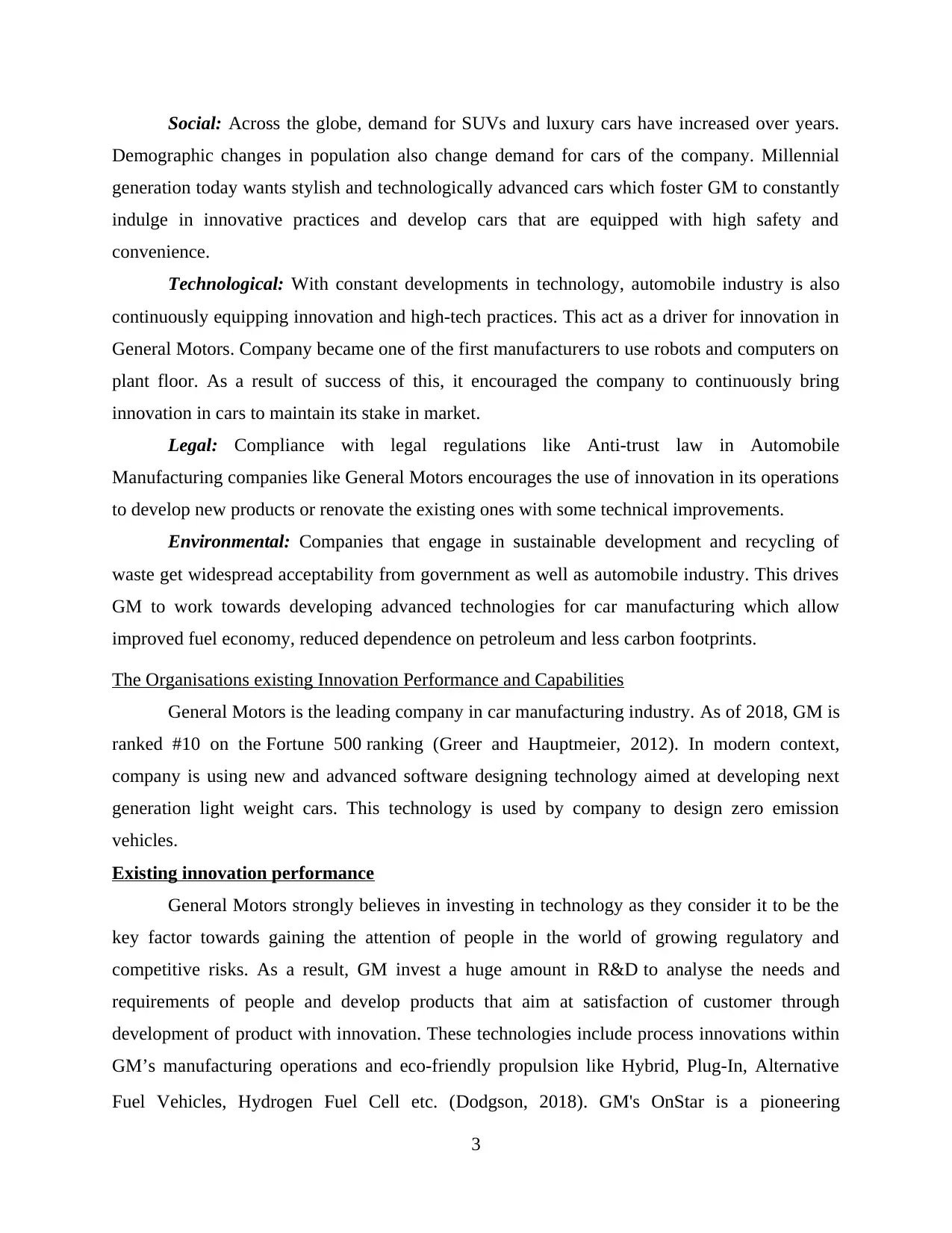
Social: Across the globe, demand for SUVs and luxury cars have increased over years.
Demographic changes in population also change demand for cars of the company. Millennial
generation today wants stylish and technologically advanced cars which foster GM to constantly
indulge in innovative practices and develop cars that are equipped with high safety and
convenience.
Technological: With constant developments in technology, automobile industry is also
continuously equipping innovation and high-tech practices. This act as a driver for innovation in
General Motors. Company became one of the first manufacturers to use robots and computers on
plant floor. As a result of success of this, it encouraged the company to continuously bring
innovation in cars to maintain its stake in market.
Legal: Compliance with legal regulations like Anti-trust law in Automobile
Manufacturing companies like General Motors encourages the use of innovation in its operations
to develop new products or renovate the existing ones with some technical improvements.
Environmental: Companies that engage in sustainable development and recycling of
waste get widespread acceptability from government as well as automobile industry. This drives
GM to work towards developing advanced technologies for car manufacturing which allow
improved fuel economy, reduced dependence on petroleum and less carbon footprints.
The Organisations existing Innovation Performance and Capabilities
General Motors is the leading company in car manufacturing industry. As of 2018, GM is
ranked #10 on the Fortune 500 ranking (Greer and Hauptmeier, 2012). In modern context,
company is using new and advanced software designing technology aimed at developing next
generation light weight cars. This technology is used by company to design zero emission
vehicles.
Existing innovation performance
General Motors strongly believes in investing in technology as they consider it to be the
key factor towards gaining the attention of people in the world of growing regulatory and
competitive risks. As a result, GM invest a huge amount in R&D to analyse the needs and
requirements of people and develop products that aim at satisfaction of customer through
development of product with innovation. These technologies include process innovations within
GM’s manufacturing operations and eco-friendly propulsion like Hybrid, Plug-In, Alternative
Fuel Vehicles, Hydrogen Fuel Cell etc. (Dodgson, 2018). GM's OnStar is a pioneering
3
Demographic changes in population also change demand for cars of the company. Millennial
generation today wants stylish and technologically advanced cars which foster GM to constantly
indulge in innovative practices and develop cars that are equipped with high safety and
convenience.
Technological: With constant developments in technology, automobile industry is also
continuously equipping innovation and high-tech practices. This act as a driver for innovation in
General Motors. Company became one of the first manufacturers to use robots and computers on
plant floor. As a result of success of this, it encouraged the company to continuously bring
innovation in cars to maintain its stake in market.
Legal: Compliance with legal regulations like Anti-trust law in Automobile
Manufacturing companies like General Motors encourages the use of innovation in its operations
to develop new products or renovate the existing ones with some technical improvements.
Environmental: Companies that engage in sustainable development and recycling of
waste get widespread acceptability from government as well as automobile industry. This drives
GM to work towards developing advanced technologies for car manufacturing which allow
improved fuel economy, reduced dependence on petroleum and less carbon footprints.
The Organisations existing Innovation Performance and Capabilities
General Motors is the leading company in car manufacturing industry. As of 2018, GM is
ranked #10 on the Fortune 500 ranking (Greer and Hauptmeier, 2012). In modern context,
company is using new and advanced software designing technology aimed at developing next
generation light weight cars. This technology is used by company to design zero emission
vehicles.
Existing innovation performance
General Motors strongly believes in investing in technology as they consider it to be the
key factor towards gaining the attention of people in the world of growing regulatory and
competitive risks. As a result, GM invest a huge amount in R&D to analyse the needs and
requirements of people and develop products that aim at satisfaction of customer through
development of product with innovation. These technologies include process innovations within
GM’s manufacturing operations and eco-friendly propulsion like Hybrid, Plug-In, Alternative
Fuel Vehicles, Hydrogen Fuel Cell etc. (Dodgson, 2018). GM's OnStar is a pioneering
3
⊘ This is a preview!⊘
Do you want full access?
Subscribe today to unlock all pages.

Trusted by 1+ million students worldwide
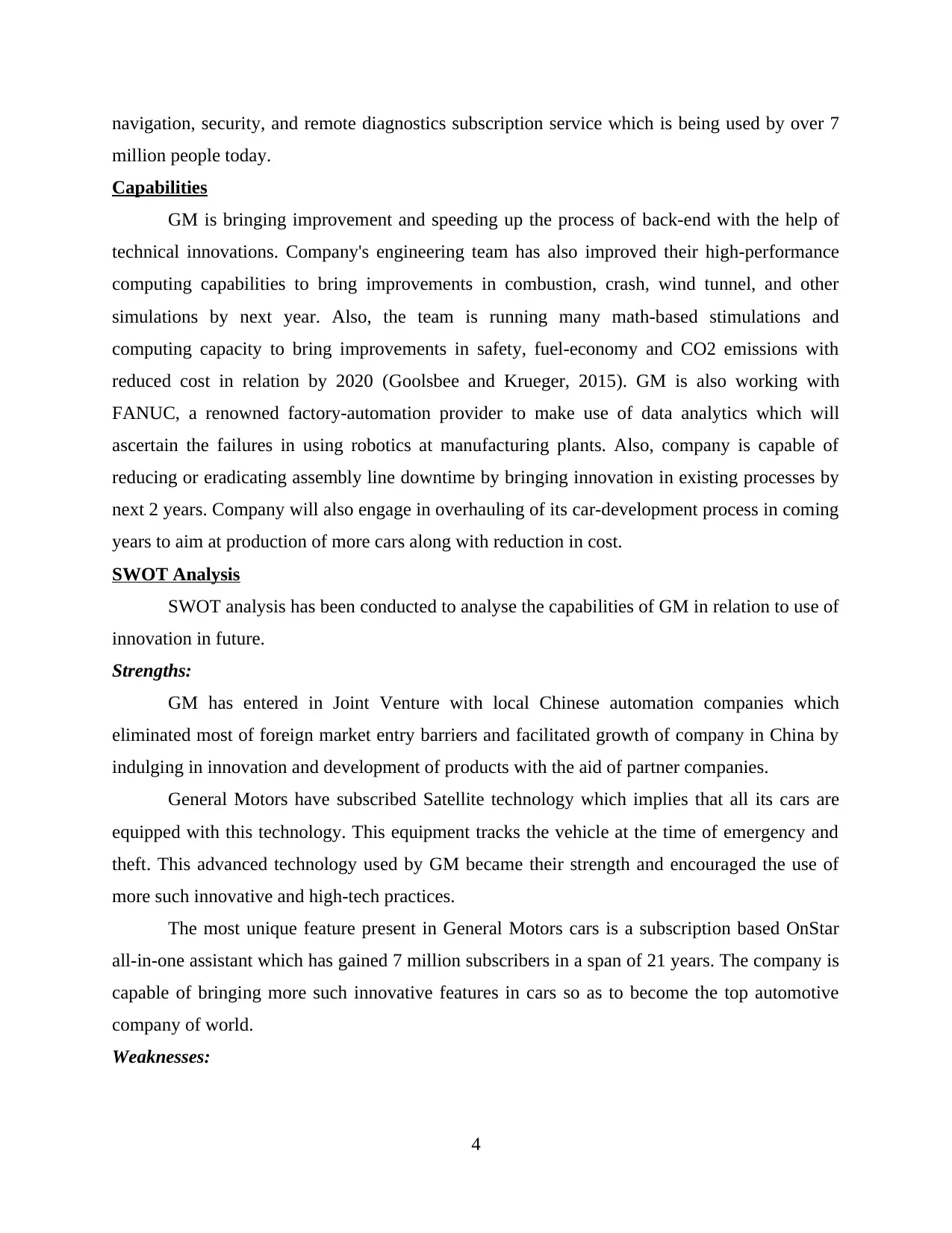
navigation, security, and remote diagnostics subscription service which is being used by over 7
million people today.
Capabilities
GM is bringing improvement and speeding up the process of back-end with the help of
technical innovations. Company's engineering team has also improved their high-performance
computing capabilities to bring improvements in combustion, crash, wind tunnel, and other
simulations by next year. Also, the team is running many math-based stimulations and
computing capacity to bring improvements in safety, fuel-economy and CO2 emissions with
reduced cost in relation by 2020 (Goolsbee and Krueger, 2015). GM is also working with
FANUC, a renowned factory-automation provider to make use of data analytics which will
ascertain the failures in using robotics at manufacturing plants. Also, company is capable of
reducing or eradicating assembly line downtime by bringing innovation in existing processes by
next 2 years. Company will also engage in overhauling of its car-development process in coming
years to aim at production of more cars along with reduction in cost.
SWOT Analysis
SWOT analysis has been conducted to analyse the capabilities of GM in relation to use of
innovation in future.
Strengths:
GM has entered in Joint Venture with local Chinese automation companies which
eliminated most of foreign market entry barriers and facilitated growth of company in China by
indulging in innovation and development of products with the aid of partner companies.
General Motors have subscribed Satellite technology which implies that all its cars are
equipped with this technology. This equipment tracks the vehicle at the time of emergency and
theft. This advanced technology used by GM became their strength and encouraged the use of
more such innovative and high-tech practices.
The most unique feature present in General Motors cars is a subscription based OnStar
all-in-one assistant which has gained 7 million subscribers in a span of 21 years. The company is
capable of bringing more such innovative features in cars so as to become the top automotive
company of world.
Weaknesses:
4
million people today.
Capabilities
GM is bringing improvement and speeding up the process of back-end with the help of
technical innovations. Company's engineering team has also improved their high-performance
computing capabilities to bring improvements in combustion, crash, wind tunnel, and other
simulations by next year. Also, the team is running many math-based stimulations and
computing capacity to bring improvements in safety, fuel-economy and CO2 emissions with
reduced cost in relation by 2020 (Goolsbee and Krueger, 2015). GM is also working with
FANUC, a renowned factory-automation provider to make use of data analytics which will
ascertain the failures in using robotics at manufacturing plants. Also, company is capable of
reducing or eradicating assembly line downtime by bringing innovation in existing processes by
next 2 years. Company will also engage in overhauling of its car-development process in coming
years to aim at production of more cars along with reduction in cost.
SWOT Analysis
SWOT analysis has been conducted to analyse the capabilities of GM in relation to use of
innovation in future.
Strengths:
GM has entered in Joint Venture with local Chinese automation companies which
eliminated most of foreign market entry barriers and facilitated growth of company in China by
indulging in innovation and development of products with the aid of partner companies.
General Motors have subscribed Satellite technology which implies that all its cars are
equipped with this technology. This equipment tracks the vehicle at the time of emergency and
theft. This advanced technology used by GM became their strength and encouraged the use of
more such innovative and high-tech practices.
The most unique feature present in General Motors cars is a subscription based OnStar
all-in-one assistant which has gained 7 million subscribers in a span of 21 years. The company is
capable of bringing more such innovative features in cars so as to become the top automotive
company of world.
Weaknesses:
4
Paraphrase This Document
Need a fresh take? Get an instant paraphrase of this document with our AI Paraphraser
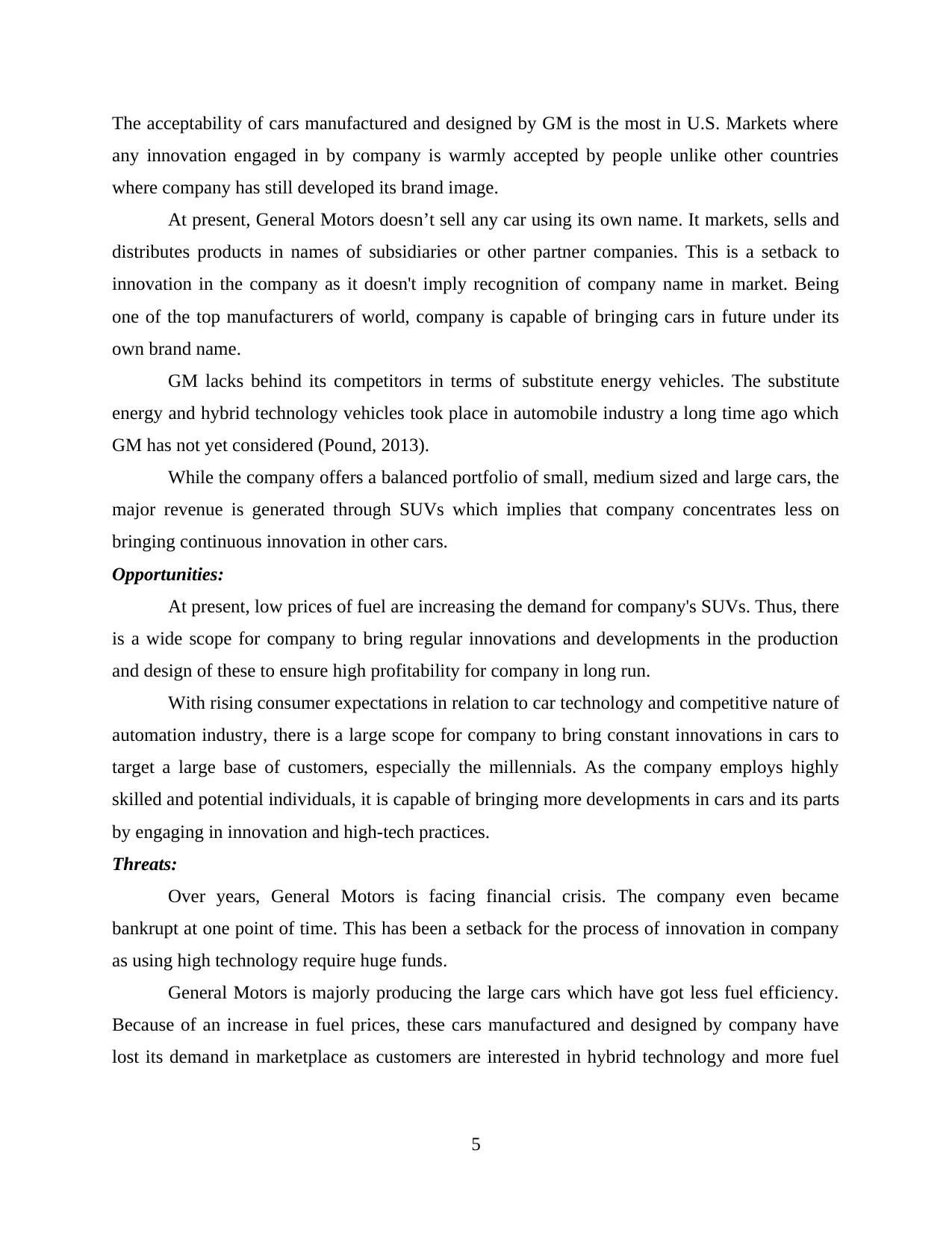
The acceptability of cars manufactured and designed by GM is the most in U.S. Markets where
any innovation engaged in by company is warmly accepted by people unlike other countries
where company has still developed its brand image.
At present, General Motors doesn’t sell any car using its own name. It markets, sells and
distributes products in names of subsidiaries or other partner companies. This is a setback to
innovation in the company as it doesn't imply recognition of company name in market. Being
one of the top manufacturers of world, company is capable of bringing cars in future under its
own brand name.
GM lacks behind its competitors in terms of substitute energy vehicles. The substitute
energy and hybrid technology vehicles took place in automobile industry a long time ago which
GM has not yet considered (Pound, 2013).
While the company offers a balanced portfolio of small, medium sized and large cars, the
major revenue is generated through SUVs which implies that company concentrates less on
bringing continuous innovation in other cars.
Opportunities:
At present, low prices of fuel are increasing the demand for company's SUVs. Thus, there
is a wide scope for company to bring regular innovations and developments in the production
and design of these to ensure high profitability for company in long run.
With rising consumer expectations in relation to car technology and competitive nature of
automation industry, there is a large scope for company to bring constant innovations in cars to
target a large base of customers, especially the millennials. As the company employs highly
skilled and potential individuals, it is capable of bringing more developments in cars and its parts
by engaging in innovation and high-tech practices.
Threats:
Over years, General Motors is facing financial crisis. The company even became
bankrupt at one point of time. This has been a setback for the process of innovation in company
as using high technology require huge funds.
General Motors is majorly producing the large cars which have got less fuel efficiency.
Because of an increase in fuel prices, these cars manufactured and designed by company have
lost its demand in marketplace as customers are interested in hybrid technology and more fuel
5
any innovation engaged in by company is warmly accepted by people unlike other countries
where company has still developed its brand image.
At present, General Motors doesn’t sell any car using its own name. It markets, sells and
distributes products in names of subsidiaries or other partner companies. This is a setback to
innovation in the company as it doesn't imply recognition of company name in market. Being
one of the top manufacturers of world, company is capable of bringing cars in future under its
own brand name.
GM lacks behind its competitors in terms of substitute energy vehicles. The substitute
energy and hybrid technology vehicles took place in automobile industry a long time ago which
GM has not yet considered (Pound, 2013).
While the company offers a balanced portfolio of small, medium sized and large cars, the
major revenue is generated through SUVs which implies that company concentrates less on
bringing continuous innovation in other cars.
Opportunities:
At present, low prices of fuel are increasing the demand for company's SUVs. Thus, there
is a wide scope for company to bring regular innovations and developments in the production
and design of these to ensure high profitability for company in long run.
With rising consumer expectations in relation to car technology and competitive nature of
automation industry, there is a large scope for company to bring constant innovations in cars to
target a large base of customers, especially the millennials. As the company employs highly
skilled and potential individuals, it is capable of bringing more developments in cars and its parts
by engaging in innovation and high-tech practices.
Threats:
Over years, General Motors is facing financial crisis. The company even became
bankrupt at one point of time. This has been a setback for the process of innovation in company
as using high technology require huge funds.
General Motors is majorly producing the large cars which have got less fuel efficiency.
Because of an increase in fuel prices, these cars manufactured and designed by company have
lost its demand in marketplace as customers are interested in hybrid technology and more fuel
5
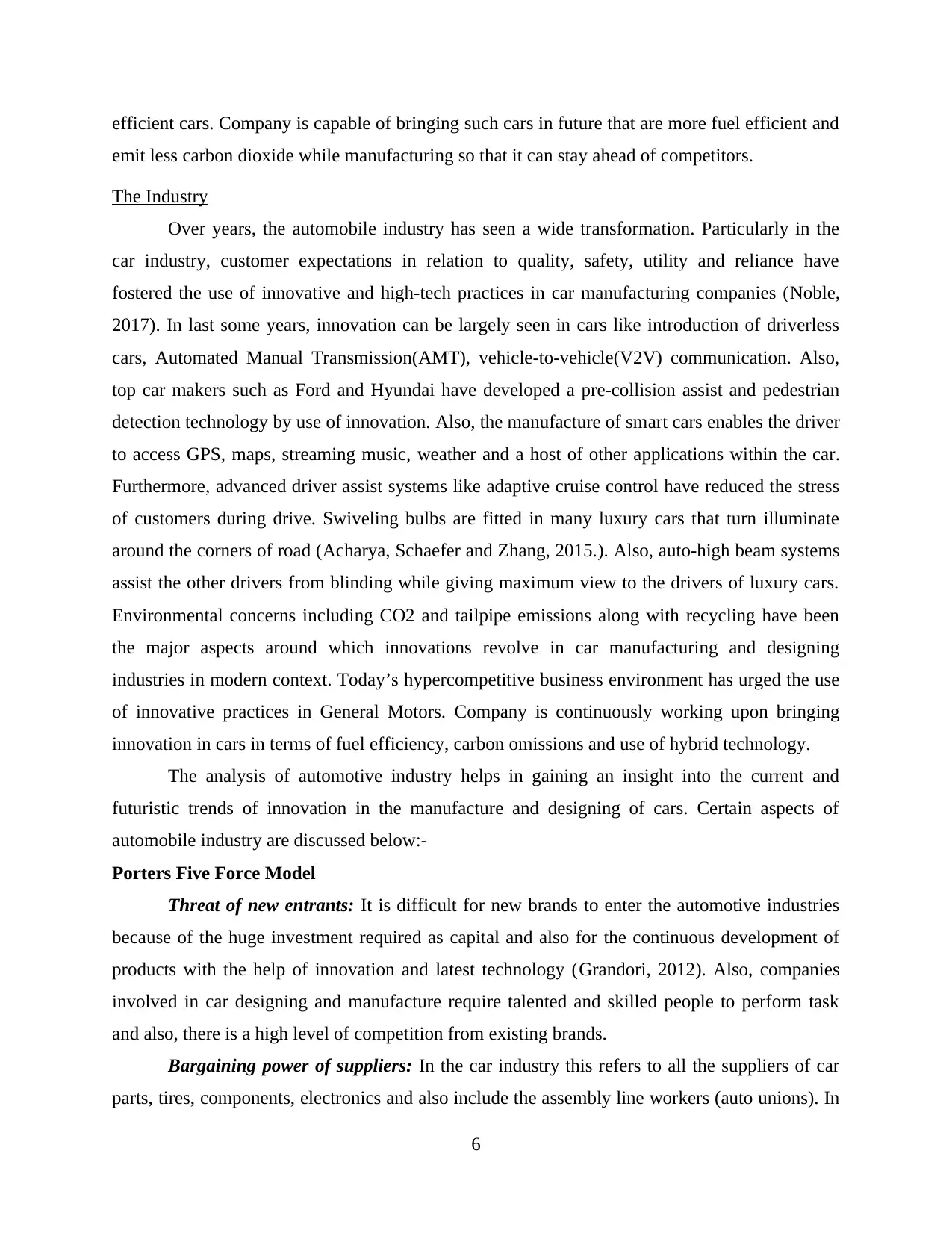
efficient cars. Company is capable of bringing such cars in future that are more fuel efficient and
emit less carbon dioxide while manufacturing so that it can stay ahead of competitors.
The Industry
Over years, the automobile industry has seen a wide transformation. Particularly in the
car industry, customer expectations in relation to quality, safety, utility and reliance have
fostered the use of innovative and high-tech practices in car manufacturing companies (Noble,
2017). In last some years, innovation can be largely seen in cars like introduction of driverless
cars, Automated Manual Transmission(AMT), vehicle-to-vehicle(V2V) communication. Also,
top car makers such as Ford and Hyundai have developed a pre-collision assist and pedestrian
detection technology by use of innovation. Also, the manufacture of smart cars enables the driver
to access GPS, maps, streaming music, weather and a host of other applications within the car.
Furthermore, advanced driver assist systems like adaptive cruise control have reduced the stress
of customers during drive. Swiveling bulbs are fitted in many luxury cars that turn illuminate
around the corners of road (Acharya, Schaefer and Zhang, 2015.). Also, auto-high beam systems
assist the other drivers from blinding while giving maximum view to the drivers of luxury cars.
Environmental concerns including CO2 and tailpipe emissions along with recycling have been
the major aspects around which innovations revolve in car manufacturing and designing
industries in modern context. Today’s hypercompetitive business environment has urged the use
of innovative practices in General Motors. Company is continuously working upon bringing
innovation in cars in terms of fuel efficiency, carbon omissions and use of hybrid technology.
The analysis of automotive industry helps in gaining an insight into the current and
futuristic trends of innovation in the manufacture and designing of cars. Certain aspects of
automobile industry are discussed below:-
Porters Five Force Model
Threat of new entrants: It is difficult for new brands to enter the automotive industries
because of the huge investment required as capital and also for the continuous development of
products with the help of innovation and latest technology (Grandori, 2012). Also, companies
involved in car designing and manufacture require talented and skilled people to perform task
and also, there is a high level of competition from existing brands.
Bargaining power of suppliers: In the car industry this refers to all the suppliers of car
parts, tires, components, electronics and also include the assembly line workers (auto unions). In
6
emit less carbon dioxide while manufacturing so that it can stay ahead of competitors.
The Industry
Over years, the automobile industry has seen a wide transformation. Particularly in the
car industry, customer expectations in relation to quality, safety, utility and reliance have
fostered the use of innovative and high-tech practices in car manufacturing companies (Noble,
2017). In last some years, innovation can be largely seen in cars like introduction of driverless
cars, Automated Manual Transmission(AMT), vehicle-to-vehicle(V2V) communication. Also,
top car makers such as Ford and Hyundai have developed a pre-collision assist and pedestrian
detection technology by use of innovation. Also, the manufacture of smart cars enables the driver
to access GPS, maps, streaming music, weather and a host of other applications within the car.
Furthermore, advanced driver assist systems like adaptive cruise control have reduced the stress
of customers during drive. Swiveling bulbs are fitted in many luxury cars that turn illuminate
around the corners of road (Acharya, Schaefer and Zhang, 2015.). Also, auto-high beam systems
assist the other drivers from blinding while giving maximum view to the drivers of luxury cars.
Environmental concerns including CO2 and tailpipe emissions along with recycling have been
the major aspects around which innovations revolve in car manufacturing and designing
industries in modern context. Today’s hypercompetitive business environment has urged the use
of innovative practices in General Motors. Company is continuously working upon bringing
innovation in cars in terms of fuel efficiency, carbon omissions and use of hybrid technology.
The analysis of automotive industry helps in gaining an insight into the current and
futuristic trends of innovation in the manufacture and designing of cars. Certain aspects of
automobile industry are discussed below:-
Porters Five Force Model
Threat of new entrants: It is difficult for new brands to enter the automotive industries
because of the huge investment required as capital and also for the continuous development of
products with the help of innovation and latest technology (Grandori, 2012). Also, companies
involved in car designing and manufacture require talented and skilled people to perform task
and also, there is a high level of competition from existing brands.
Bargaining power of suppliers: In the car industry this refers to all the suppliers of car
parts, tires, components, electronics and also include the assembly line workers (auto unions). In
6
⊘ This is a preview!⊘
Do you want full access?
Subscribe today to unlock all pages.

Trusted by 1+ million students worldwide
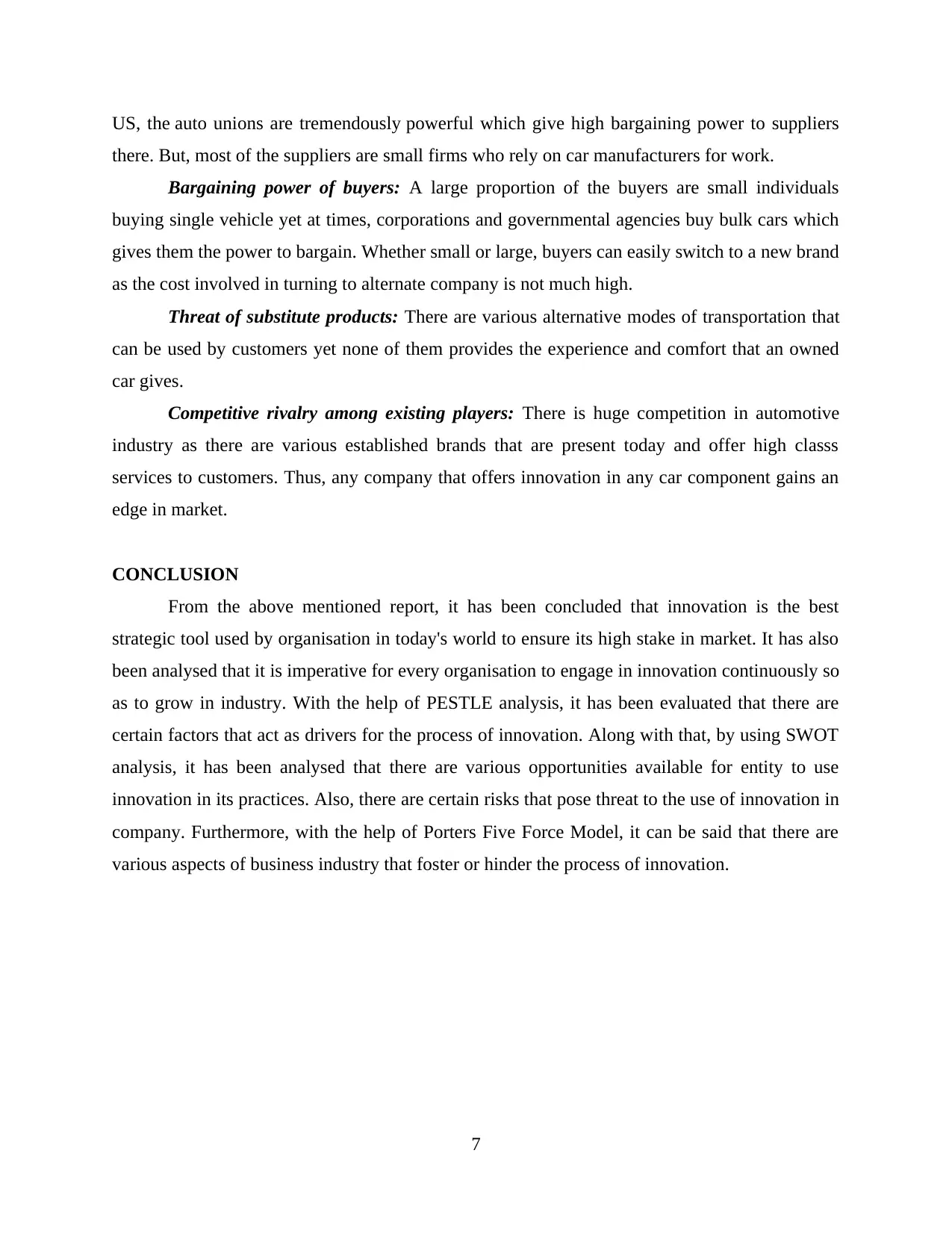
US, the auto unions are tremendously powerful which give high bargaining power to suppliers
there. But, most of the suppliers are small firms who rely on car manufacturers for work.
Bargaining power of buyers: A large proportion of the buyers are small individuals
buying single vehicle yet at times, corporations and governmental agencies buy bulk cars which
gives them the power to bargain. Whether small or large, buyers can easily switch to a new brand
as the cost involved in turning to alternate company is not much high.
Threat of substitute products: There are various alternative modes of transportation that
can be used by customers yet none of them provides the experience and comfort that an owned
car gives.
Competitive rivalry among existing players: There is huge competition in automotive
industry as there are various established brands that are present today and offer high classs
services to customers. Thus, any company that offers innovation in any car component gains an
edge in market.
CONCLUSION
From the above mentioned report, it has been concluded that innovation is the best
strategic tool used by organisation in today's world to ensure its high stake in market. It has also
been analysed that it is imperative for every organisation to engage in innovation continuously so
as to grow in industry. With the help of PESTLE analysis, it has been evaluated that there are
certain factors that act as drivers for the process of innovation. Along with that, by using SWOT
analysis, it has been analysed that there are various opportunities available for entity to use
innovation in its practices. Also, there are certain risks that pose threat to the use of innovation in
company. Furthermore, with the help of Porters Five Force Model, it can be said that there are
various aspects of business industry that foster or hinder the process of innovation.
7
there. But, most of the suppliers are small firms who rely on car manufacturers for work.
Bargaining power of buyers: A large proportion of the buyers are small individuals
buying single vehicle yet at times, corporations and governmental agencies buy bulk cars which
gives them the power to bargain. Whether small or large, buyers can easily switch to a new brand
as the cost involved in turning to alternate company is not much high.
Threat of substitute products: There are various alternative modes of transportation that
can be used by customers yet none of them provides the experience and comfort that an owned
car gives.
Competitive rivalry among existing players: There is huge competition in automotive
industry as there are various established brands that are present today and offer high classs
services to customers. Thus, any company that offers innovation in any car component gains an
edge in market.
CONCLUSION
From the above mentioned report, it has been concluded that innovation is the best
strategic tool used by organisation in today's world to ensure its high stake in market. It has also
been analysed that it is imperative for every organisation to engage in innovation continuously so
as to grow in industry. With the help of PESTLE analysis, it has been evaluated that there are
certain factors that act as drivers for the process of innovation. Along with that, by using SWOT
analysis, it has been analysed that there are various opportunities available for entity to use
innovation in its practices. Also, there are certain risks that pose threat to the use of innovation in
company. Furthermore, with the help of Porters Five Force Model, it can be said that there are
various aspects of business industry that foster or hinder the process of innovation.
7
Paraphrase This Document
Need a fresh take? Get an instant paraphrase of this document with our AI Paraphraser
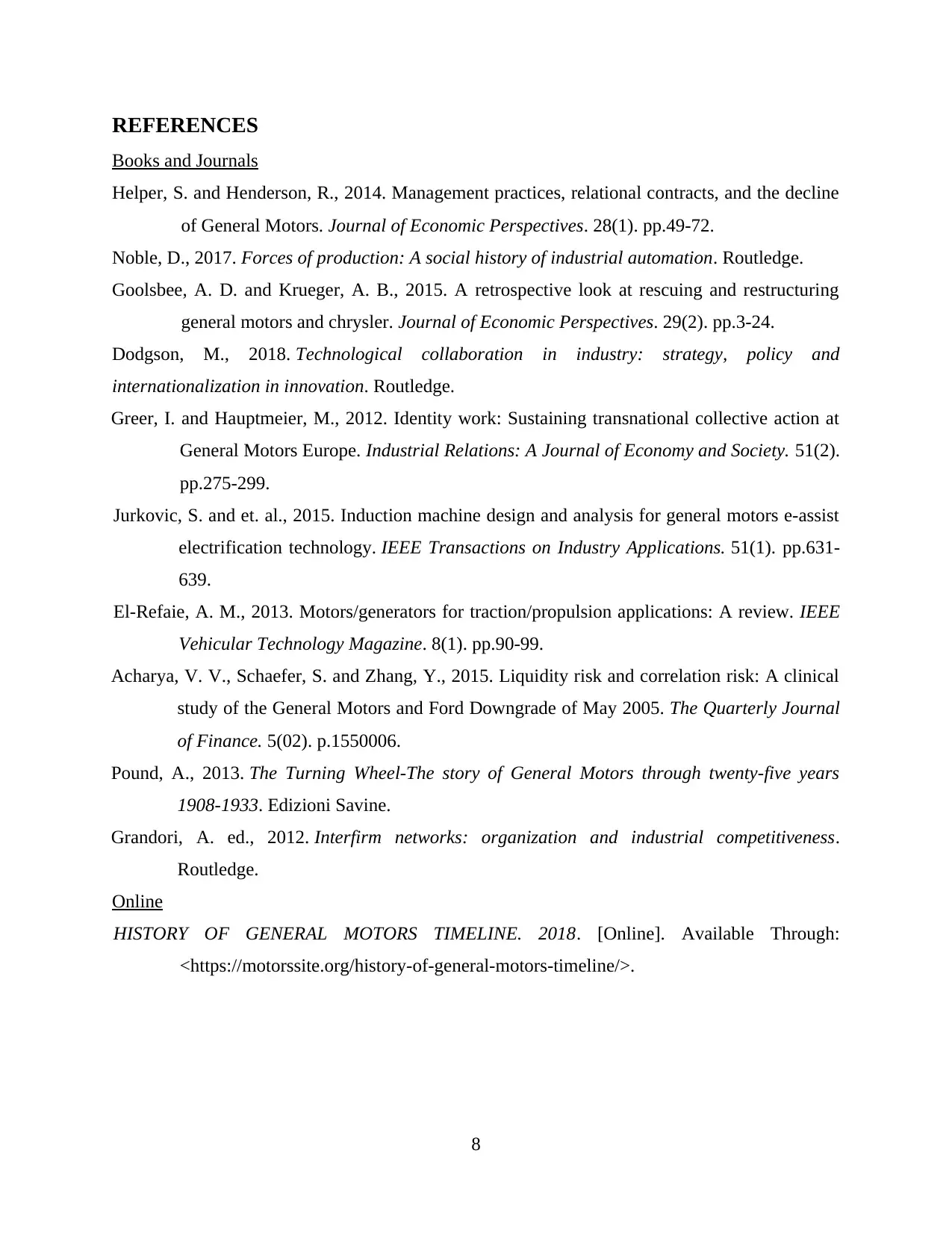
REFERENCES
Books and Journals
Helper, S. and Henderson, R., 2014. Management practices, relational contracts, and the decline
of General Motors. Journal of Economic Perspectives. 28(1). pp.49-72.
Noble, D., 2017. Forces of production: A social history of industrial automation. Routledge.
Goolsbee, A. D. and Krueger, A. B., 2015. A retrospective look at rescuing and restructuring
general motors and chrysler. Journal of Economic Perspectives. 29(2). pp.3-24.
Dodgson, M., 2018. Technological collaboration in industry: strategy, policy and
internationalization in innovation. Routledge.
Greer, I. and Hauptmeier, M., 2012. Identity work: Sustaining transnational collective action at
General Motors Europe. Industrial Relations: A Journal of Economy and Society. 51(2).
pp.275-299.
Jurkovic, S. and et. al., 2015. Induction machine design and analysis for general motors e-assist
electrification technology. IEEE Transactions on Industry Applications. 51(1). pp.631-
639.
El-Refaie, A. M., 2013. Motors/generators for traction/propulsion applications: A review. IEEE
Vehicular Technology Magazine. 8(1). pp.90-99.
Acharya, V. V., Schaefer, S. and Zhang, Y., 2015. Liquidity risk and correlation risk: A clinical
study of the General Motors and Ford Downgrade of May 2005. The Quarterly Journal
of Finance. 5(02). p.1550006.
Pound, A., 2013. The Turning Wheel-The story of General Motors through twenty-five years
1908-1933. Edizioni Savine.
Grandori, A. ed., 2012. Interfirm networks: organization and industrial competitiveness.
Routledge.
Online
HISTORY OF GENERAL MOTORS TIMELINE. 2018. [Online]. Available Through:
<https://motorssite.org/history-of-general-motors-timeline/>.
8
Books and Journals
Helper, S. and Henderson, R., 2014. Management practices, relational contracts, and the decline
of General Motors. Journal of Economic Perspectives. 28(1). pp.49-72.
Noble, D., 2017. Forces of production: A social history of industrial automation. Routledge.
Goolsbee, A. D. and Krueger, A. B., 2015. A retrospective look at rescuing and restructuring
general motors and chrysler. Journal of Economic Perspectives. 29(2). pp.3-24.
Dodgson, M., 2018. Technological collaboration in industry: strategy, policy and
internationalization in innovation. Routledge.
Greer, I. and Hauptmeier, M., 2012. Identity work: Sustaining transnational collective action at
General Motors Europe. Industrial Relations: A Journal of Economy and Society. 51(2).
pp.275-299.
Jurkovic, S. and et. al., 2015. Induction machine design and analysis for general motors e-assist
electrification technology. IEEE Transactions on Industry Applications. 51(1). pp.631-
639.
El-Refaie, A. M., 2013. Motors/generators for traction/propulsion applications: A review. IEEE
Vehicular Technology Magazine. 8(1). pp.90-99.
Acharya, V. V., Schaefer, S. and Zhang, Y., 2015. Liquidity risk and correlation risk: A clinical
study of the General Motors and Ford Downgrade of May 2005. The Quarterly Journal
of Finance. 5(02). p.1550006.
Pound, A., 2013. The Turning Wheel-The story of General Motors through twenty-five years
1908-1933. Edizioni Savine.
Grandori, A. ed., 2012. Interfirm networks: organization and industrial competitiveness.
Routledge.
Online
HISTORY OF GENERAL MOTORS TIMELINE. 2018. [Online]. Available Through:
<https://motorssite.org/history-of-general-motors-timeline/>.
8
1 out of 11
Related Documents
Your All-in-One AI-Powered Toolkit for Academic Success.
+13062052269
info@desklib.com
Available 24*7 on WhatsApp / Email
![[object Object]](/_next/static/media/star-bottom.7253800d.svg)
Unlock your academic potential
Copyright © 2020–2025 A2Z Services. All Rights Reserved. Developed and managed by ZUCOL.





